Evaluation of Water Resources through Efficiency Index and Water Productivity in EU
Abstract
1. Introduction
2. Present State of Problem Solving
3. Materials and Methods
- Evaluation of the contribution of Operational Programs to the implementation of EU water policy
- Key descriptive statistics on the consideration of water issues in the Rural Development Programs 2014–2020
- Guidance on a “Good Practice” RDP from a water perspective [31].
- -
- Water efficiency index (WEI).
- -
- Productivity of water.
3.1. Water Efficiency Index (WEI)
3.2. Water Productivity
4. Results
5. Discussion
6. Conclusions
Author Contributions
Funding
Data Availability Statement
Conflicts of Interest
References
- Kleidorfer, M.; Mikovits, C.; Jasper-Tönnies, A.; Huttenlau, M.; Einfalt, T.; Rauch, W. Impact of a Changing Environment on Drainage System Performance. Procedia Eng. 2014, 70, 943–950. [Google Scholar] [CrossRef][Green Version]
- Misachi, J. What Percentage of the Earth’s Water Is Drinkable? World Atlas: Environment. 2018. Available online: https://www.worldatlas.com/articles/what-percentage-of-the-earth-s-water-is-drinkable.html (accessed on 13 December 2021).
- Alcamo, J.; Henrichs, T.; Rosch, T. World Water in 2025: Global Modeling and Scenario Analysis for the World Commission on Water for the 21th Century. Center for Environmental Systems Research. 2000. Available online: http://www.env-edu.gr/Documents/World%20Water%20in%202025.pdf (accessed on 13 December 2021).
- Seckler, D.; Molden, U.D.M.; de Silva, R.; Barker, R. World Water Demand and Supply, 1990 to 2025: Scenarios and Issues. International Water Management Institute. 1998. Available online: https://www.joinforwater.ngo/sites/default/files/library_assets/W_ALG_E22_World_Water.PDF (accessed on 2 November 2021).
- Worldmeter. Water. Available online: https://www.worldometers.info/ (accessed on 20 February 2022).
- Rosegrant, M.W. Global water outlook to 2025: Averting an Impending Crisis. International Water Management Institute. 2002. Available online: https://www.researchgate.net/publication/5056530_Global_water_outlook_to_2025 (accessed on 20 February 2022).
- Decree 2000/60/ES European Parliament and Council from 23rd October 20000. Available online: https://eur-lex.europa.eu/legal-content/SK/TXT/PDF/?uri=CELEX:02000L0060-20090625&from=ET (accessed on 15 October 2021).
- Liu, J.; Yang, H.; Gosling, S.N.; Kummu, M.; Flörke, M.; Pfister, S.; Hanasaki, N.; Wada, Y.; Zhang, X.; Zheng, C.; et al. Water scarcity assessments in the past, present, and future. Earth Future 2017, 5, 545–559. [Google Scholar] [CrossRef] [PubMed]
- Mancosu, N.; Snyder, R.L.; Kyriakakis, G.; Spano, D. Water Scarcity and Future Challenges for Food Production. Water 2015, 7, 975–992. [Google Scholar] [CrossRef]
- Doeffinger, T.; Hall, J.W. Water Stress and Productivity: An Empirical Analysis of Trends and Drivers. Water Resour. Res. 2020, 56, e2019WR025925. [Google Scholar] [CrossRef]
- Frizzone, J.A.; Lima, S.C.R.V.; Lacerda, C.F.; Mateos, L. Socio-Economic Indexes for Water Use in Irrigation in a Representative Basin of the Tropical Semiarid Region. Water 2021, 13, 2643. [Google Scholar] [CrossRef]
- Koech, R.; Langat, P. Improving Irrigation Water Use Efficiency: A Review of Advances, Challenges and Opportunities in the Australian Context. Water 2018, 10, 1771. [Google Scholar] [CrossRef]
- Rodrigues, G.C.; Pereira, L.S. Assessing economic impacts of deficit irrigation as related to water productivity and water costs. Biosyst. Eng. 2009, 103, 536–551. [Google Scholar] [CrossRef]
- Cheng, C.-L.; Peng, J.-J.; Ho, M.-C.; Liao, W.-J.; Chern, S.-J. Evaluation of Water Efficiency in Green Building in Taiwan. Water 2016, 8, 236. [Google Scholar] [CrossRef]
- Vásquez-Lavín, F.O.L.V.; Hernández, J.I.; Oliva, R.D.P. Water demand in the Chilean manufacturing industry: Analysis of the economic value of water and demand elasticities. Water Resour. Econ. 2020, 32, 100159. [Google Scholar] [CrossRef]
- Hu, J.-L.; Wang, S.-C.; Yeh, F.-Y. Total-factor water efficiency of regions in China. Resour. Policy 2006, 31, 217–230. [Google Scholar] [CrossRef]
- Yao, X.; Feng, W.; Zhang, X.; Wang, W.; Zhang, C.; You, S. Measurement and decomposition of industrial green total factor water efficiency in China. J. Clean. Prod. 2018, 198, 1144–1156. [Google Scholar] [CrossRef]
- Zheng, J.; Zhang, H.; Xing, Z. Re-Examining Regional Total-Factor Water Efficiency and Its Determinants in China: A Parametric Distance Function Approach. Water 2018, 10, 1286. [Google Scholar] [CrossRef]
- Kaneko, S.; Tanaka, K.; Toyota, T.; Managi, S. Water Efficiency of Agricultural Production in China: Regional Comparison from 1999 to 2002. Int. J. Agric. Resour. Gov. Ecol. 2004, 3, 231–251. Available online: https://www.inderscienceonline.com/doi/abs/10.1504/IJARGE.2004.006038 (accessed on 13 December 2021). [CrossRef]
- Mo, X.; Liu, S.; Lin, Z.; Xu, Y.; Xiang, Y.; McVicar, T. Prediction of crop yield, water consumption and water use efficiency with a SVAT-crop growth model using remotely sensed data on the North China Plain. Ecol. Model. 2005, 183, 301–322. [Google Scholar] [CrossRef]
- Huang, Y.; Chen, L.; Fu, B.; Huang, Z.; Gong, J. The wheat yields and water-use efficiency in the Loess Plateau: Straw mulch and irrigation effects. Agric. Water Manag. 2005, 72, 209–222. [Google Scholar] [CrossRef]
- Velasco-Muñoz, J.F.; Aznar-Sánchez, J.A.; Belmonte-Ureña, L.J.; López-Serrano, M.J. Advances in Water Use Efficiency in Agriculture: A Bibliometric Analysis. Water 2018, 10, 377. [Google Scholar] [CrossRef]
- Wang, X.Y.; Zhao, L.G. Water Efficiency and Influencing Factors of China’s Agriculture: The SFA Analysis Based on Provincial Panel Data, 1997–2006. Issues Agric. Econ. 2008, 3, 10–17. Available online: https://www.researchgate.net/publication/340034205_Analysis_of_water_use_efficiency_and_influencing_factors_of_agricultural_total_factors_in_Beijing-Tianjin-Hebei_region (accessed on 2 November 2021).
- Li, S.X.; Cheng, J.H.; Wu, Q.S. Regional Difference of the Efficiency of Water Usage in China. China Popul. Resour. Environ. 2008, 3, 215–220. Available online: https://www.researchgate.net/publication/336486394_Regional_Difference_of_the_Efficiency_of_Water_Usage_in_China (accessed on 2 November 2021).
- Pereira, L.S.; Cordery, I.; Iacovides, I. Improved indicators of water use performance and productivity for sustainable water conservation and saving. Agric. Water Manag. 2012, 108, 39–51. [Google Scholar] [CrossRef]
- Hoekstra, A.Y.; Chapagain, A.K.; van Oel, P.R. Progress in Water Footprint Assessment: Towards Collective Action in Water Governance. Water 2019, 11, 1070. [Google Scholar] [CrossRef]
- Lathuillière, M.J.; Coe, M.T.; Castanho, A.; Graesser, J.; Johnson, M.S. Evaluating Water Use for Agricultural Intensification in Southern Amazonia Using the Water Footprint Sustainability Assessment. Water 2018, 10, 349. [Google Scholar] [CrossRef]
- Fialkiewicz, W.; Burszta-Adamiak, E.; Kolonko-Wiercik, A.; Manzardo, A.; Loss, A.; Mikovits, C.; Scipioni, A. Simplified Direct Water Footprint Model to Support Urban Water Management. Water 2018, 10, 630. [Google Scholar] [CrossRef]
- Owusu-Sekyere, E.; Mahlathi, Y.; Jordaan, H. Understanding South African consumers’ preferences and market potential for products with low water and carbon footprints. Agrekon 2019, 58, 354–368. [Google Scholar] [CrossRef]
- Adetoro, A.A.; Abraham, S.; Paraskevopoulos, A.L.; Owusu-Sekyere, E.; Jordaan, H.; Orimoloye, I.R. Alleviating water shortages by decreasing water footprint in sugarcane production: The impacts of different soil mulching and irrigation systems in South Africa. Groundw. Sustain. Dev. 2020, 11, 100464. [Google Scholar] [CrossRef]
- Adetoro, A.A.; Ngidi, M.; Nyam, Y.S.; Orimoloye, I.R. Temporal evaluation of global trends in water footprint, water sustainability and water productivity research. Sci. Afr. 2021, 12, e00732. [Google Scholar] [CrossRef]
- Abrate, G.; Bruno, C.; Erbetta, F.; Fraquelli, G.; Giolitti, A. Efficiency in the Consolidation of the Italian Water Sector. Water Resour. Manag. 2016, 31, 2447–2463. [Google Scholar] [CrossRef]
- Water Economy. 2021. Available online: http://www.kvhk.sk/dokumenty/predmety_katedry/vodne_hospodarstvo/vodne_zdroje_10.pdf (accessed on 30 September 2021).
- Water Index. 2021. Available online: https://ec.europa.eu/environment/water/index_en.htm (accessed on 30 September 2021).
- Water Productivity. 2021. Available online: http://www1.enviroportal.sk/pdf/indikatory/0105/10551/GG_VODA_Produktivita_IL_12.pdf (accessed on 30 September 2021).
- Bauters, M.; Meeus, S.; Barthel, M.; Stoffelen, P.; De Deurwaerder, H.P.T.; Meunier, F.; Drake, T.W.; Ponette, Q.; Ebuy, J.; Vermeir, P.; et al. Century-long apparent decrease in intrinsic water-use efficiency with no evidence of progressive nutrient limitation in African tropical forests. Glob. Chang. Biol. 2020, 26, 4449–4461. [Google Scholar] [CrossRef]
- Abu-Bakar, H.; Williams, L.; Hallett, S.H. A review of household water demand management and consumption measurement. J. Clean. Prod. 2021, 292, 125872. [Google Scholar] [CrossRef]
- European Environment Agency. Available online: https://www.eea.europa.eu (accessed on 19 December 2018).
- Liu, Q.; Browne, A.L.; Iossifova, D. Creating water demand: Bathing practice performances in a Chinese hot spring tourist town. J. Sustain. Tour. 2021, 30, 685–703. [Google Scholar] [CrossRef]
- Lyulyov, O.; Pimonenko, T.; Kwilinski, A.; Dzwigol, H.; Dzwigol-Barosz, M.; Pavlyk, V.; Barosz, P. The Impact of the Government Policy on the Energy Efficient Gap: The Evidence from Ukraine. Energies 2021, 14, 373. [Google Scholar] [CrossRef]
- Taušová, M.; Mihaliková, E.; Čulková, K.; Stehlíková, B.; Tauš, P.; Kudelas, D.; Štrba, Ľ. Recycling of Communal Waste: Current State and Future Potential for Sustainable Development in the EU. Sustainability 2019, 11, 2904. [Google Scholar] [CrossRef]
- Taušová, M.; Mihaliková, E.; Čulková, K.; Stehlíková, B.; Tauš, P.; Kudelas, D.; Štrba, Ľ.; Domaracká, L. Analysis of Municipal Waste Development and Management in Self-Governing Regions of Slovakia. Sustainability 2020, 12, 5818. [Google Scholar] [CrossRef]
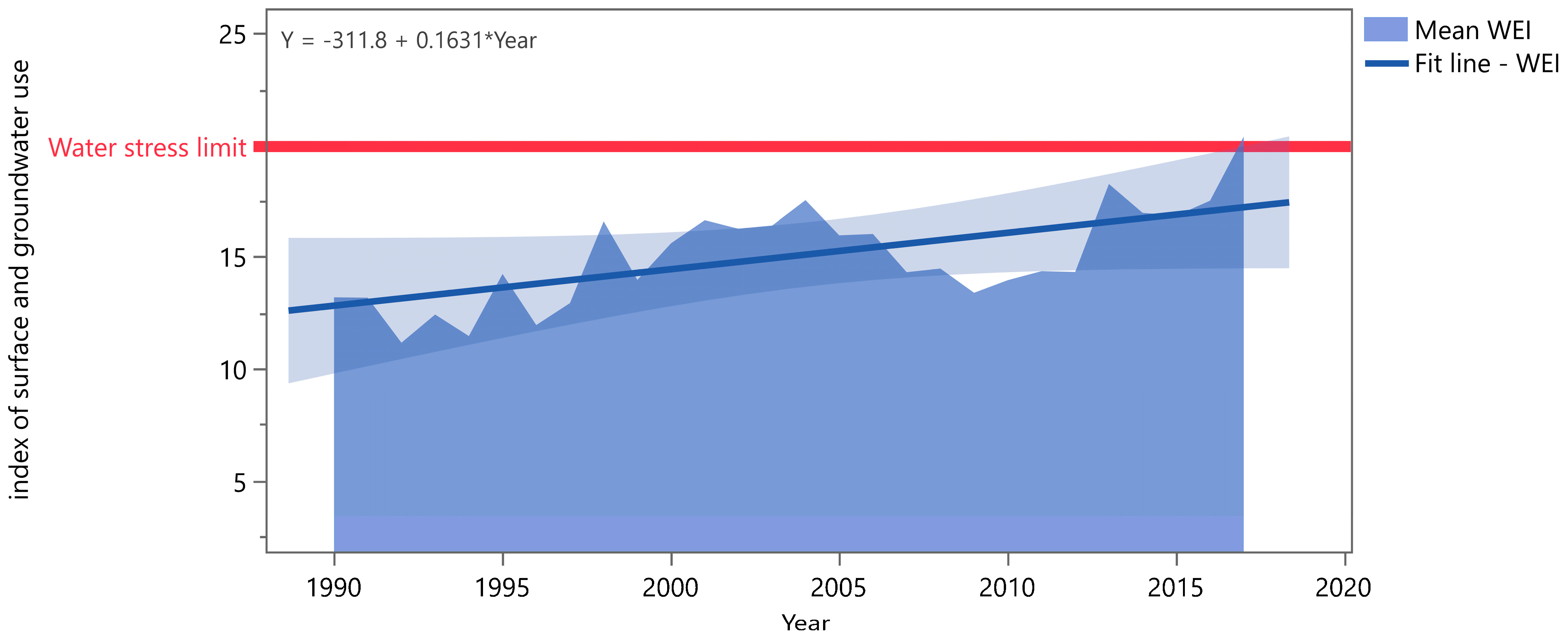
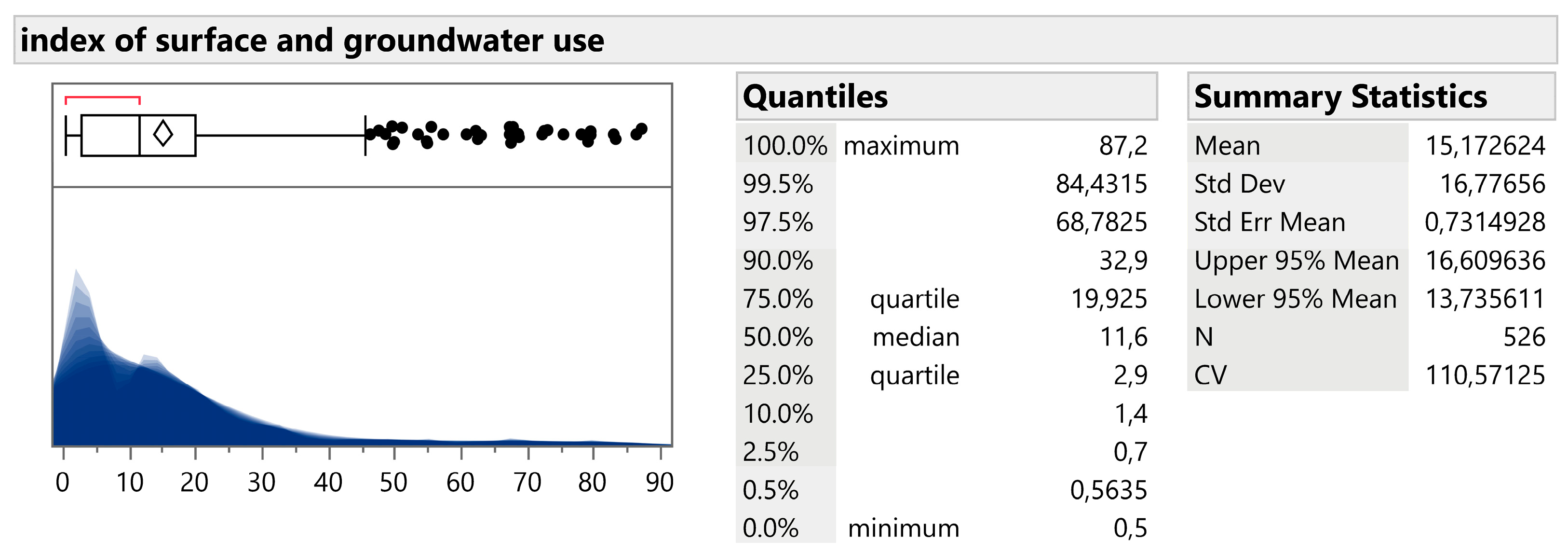

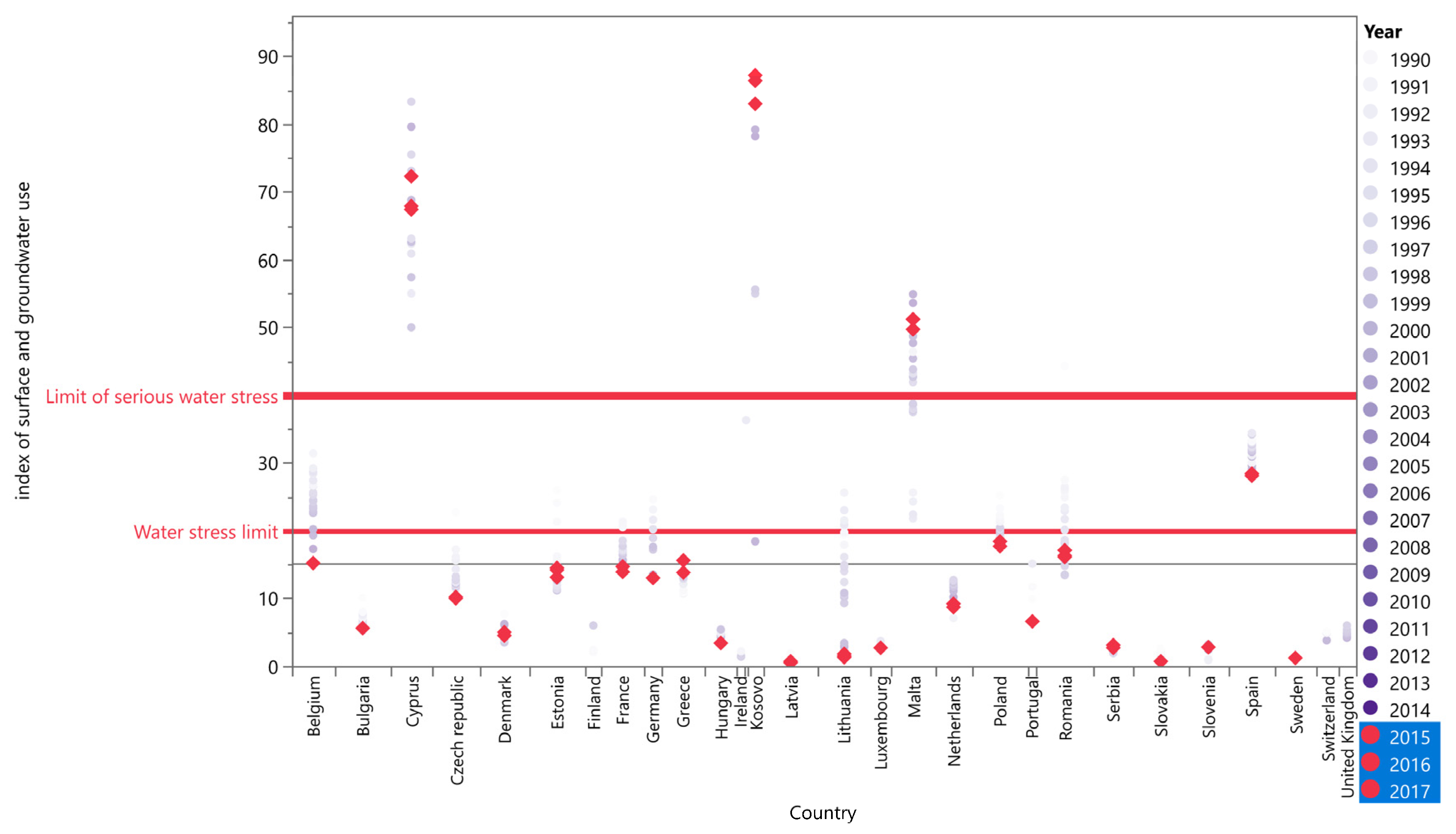
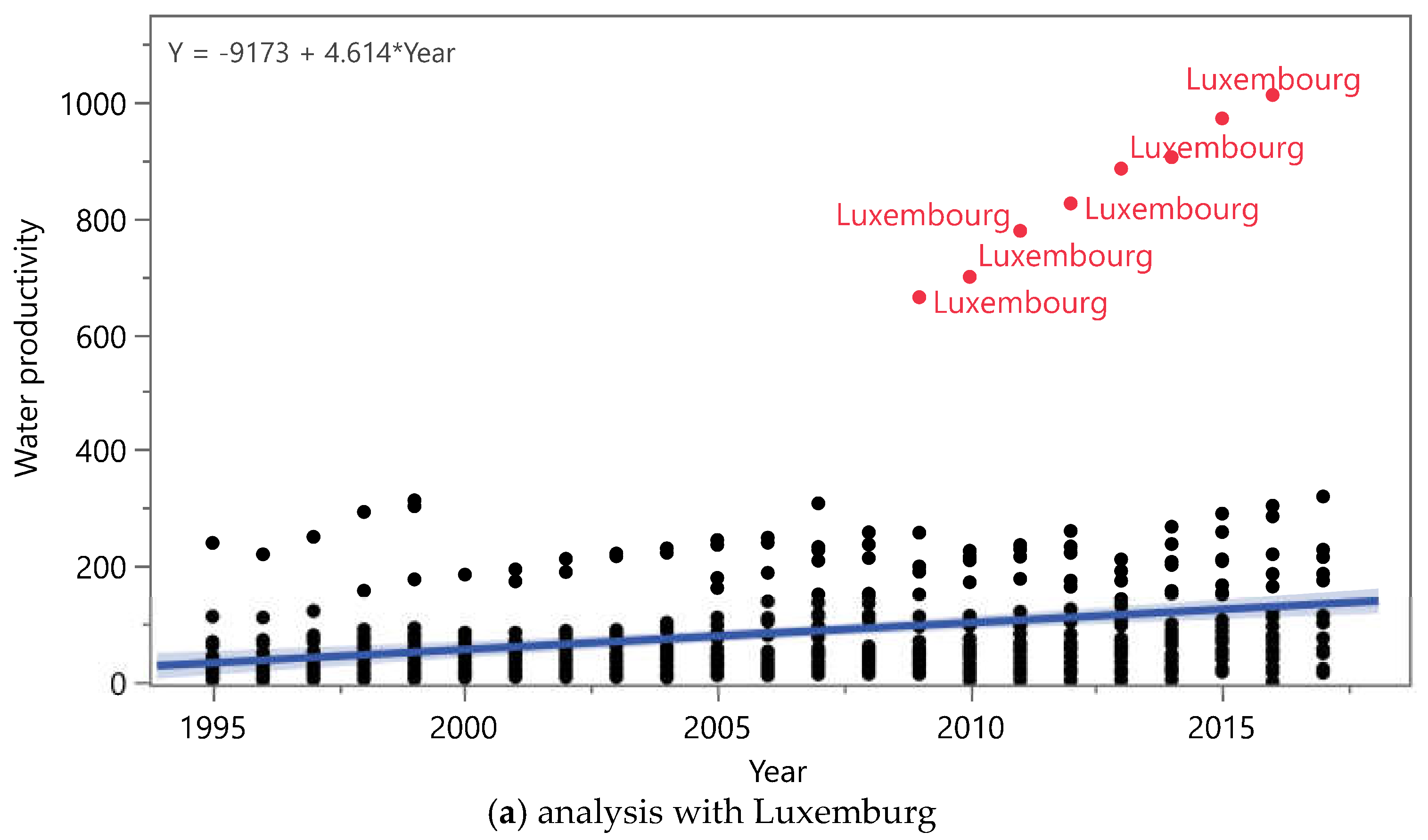
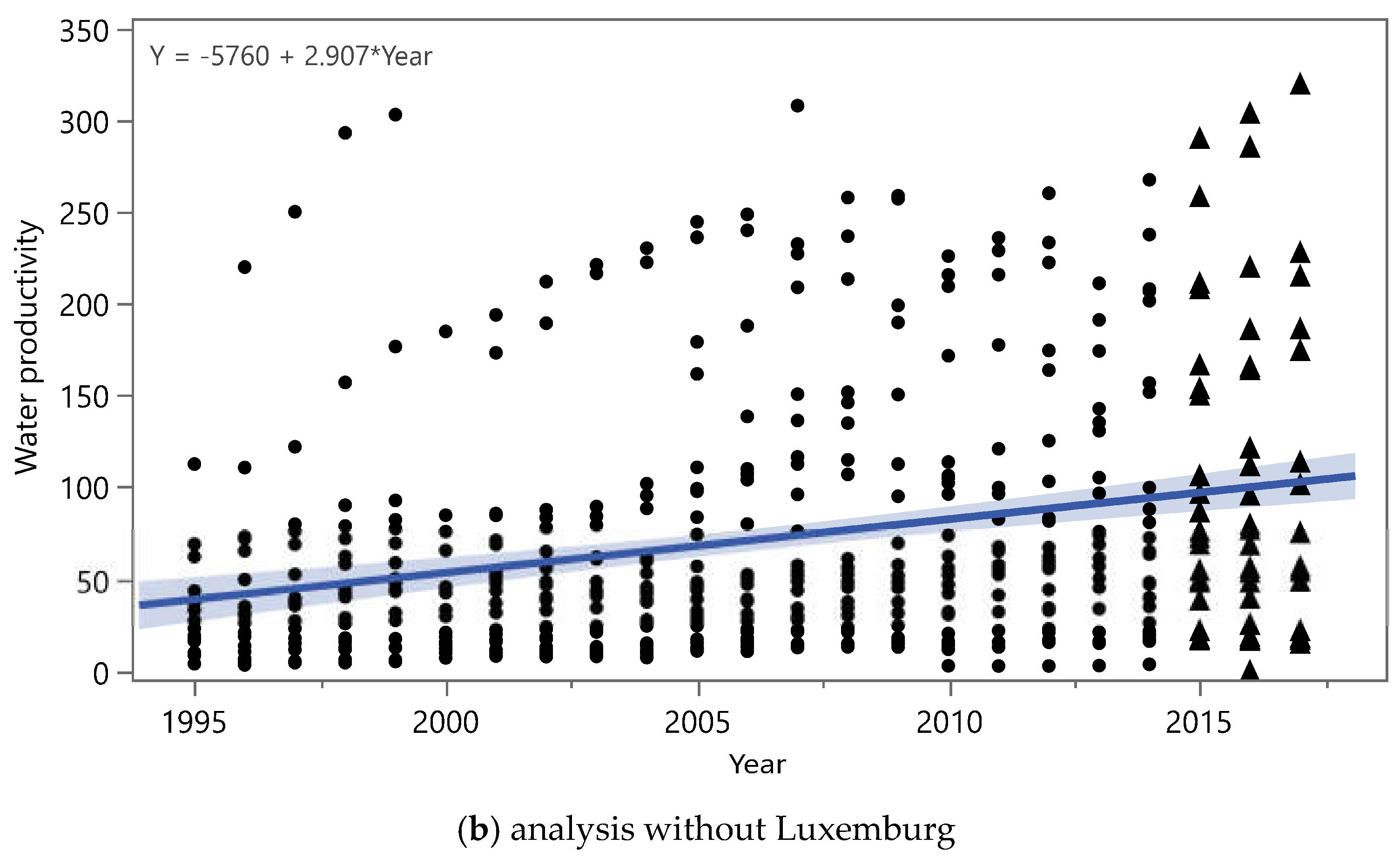

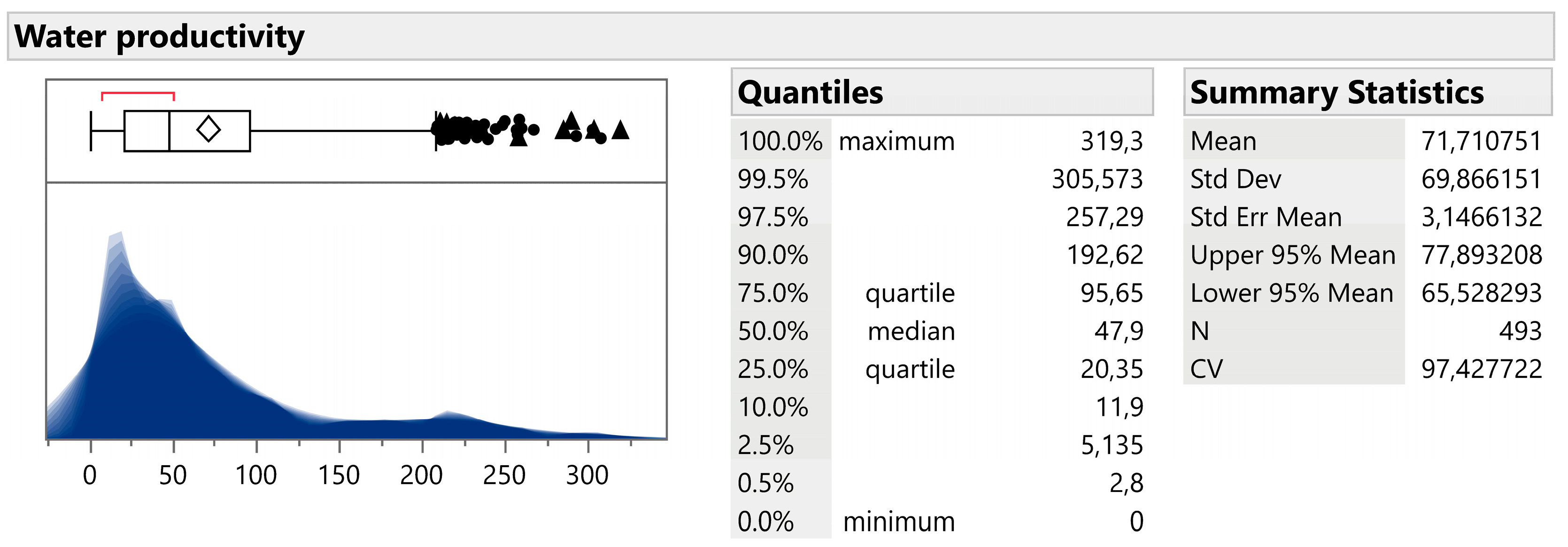

| FAO Code | Country | Average Precipitation 1961–1990 (km3/year) | Internal Resources: Surface (km3/year) | Internal Resources: Groundwater (km3/year) | Internal Resources: Overlap (km3/year) | Internal Resources: Total (km3/year) | External Resources: Natural (km3/year) | External Resources: Actual (km3/year) | Total Resources: Natural (km3/year) | Total Resources: Actual (km3/year) | IRWR/Inhab. (m3/year) |
|---|---|---|---|---|---|---|---|---|---|---|---|
| 21 | Brazil | 15,236 | 5418 | 1874 | 1874 | 5418 | 2815 | 2815 | 8233 | 8233 | 31,795 |
| 185 | Russia | 7855 | 4037 | 788 | 512 | 4313 | 195 | 195 | 4507 | 4507 | 29,642 |
| 33 | Canada | 5352 | 2840 | 370 | 360 | 2850 | 52 | 52 | 2902 | 2902 | 92,662 |
| 101 | Indonesia | 5147 | 2793 | 455 | 410 | 2838 | 0 | 0 | 2838 | 2838 | 13,381 |
| 41 | China, Mainland | 5995 | 2712 | 829 | 728 | 2812 | 17 | 17 | 2830 | 2830 | 2245 |
| 44 | Colombia | 2975 | 2112 | 510 | 510 | 2112 | 20 | 20 | 2132 | 2132 | 50,160 |
| 231 | USA | 5800 | 1862 | 1300 | 1162 | 2000 | 71 | 71 | 2071 | 2071 | 7153 |
| 170 | Peru | 1919 | 1616 | 303 | 303 | 1616 | 297 | 297 | 1913 | 1913 | 62,973 |
| 100 | India | 3559 | 1222 | 419 | 380 | 1261 | 647 | 636 | 1908 | 1897 | 1249 |
Publisher’s Note: MDPI stays neutral with regard to jurisdictional claims in published maps and institutional affiliations. |
© 2022 by the authors. Licensee MDPI, Basel, Switzerland. This article is an open access article distributed under the terms and conditions of the Creative Commons Attribution (CC BY) license (https://creativecommons.org/licenses/by/4.0/).
Share and Cite
Taušová, M.; Čulková, K.; Kudelas, D.; Gabániová, Ľ.; Koščo, J.; Mehana, I. Evaluation of Water Resources through Efficiency Index and Water Productivity in EU. Energies 2022, 15, 9123. https://doi.org/10.3390/en15239123
Taušová M, Čulková K, Kudelas D, Gabániová Ľ, Koščo J, Mehana I. Evaluation of Water Resources through Efficiency Index and Water Productivity in EU. Energies. 2022; 15(23):9123. https://doi.org/10.3390/en15239123
Chicago/Turabian StyleTaušová, Marcela, Katarína Čulková, Dušan Kudelas, Ľubomíra Gabániová, Ján Koščo, and Ibrahim Mehana. 2022. "Evaluation of Water Resources through Efficiency Index and Water Productivity in EU" Energies 15, no. 23: 9123. https://doi.org/10.3390/en15239123
APA StyleTaušová, M., Čulková, K., Kudelas, D., Gabániová, Ľ., Koščo, J., & Mehana, I. (2022). Evaluation of Water Resources through Efficiency Index and Water Productivity in EU. Energies, 15(23), 9123. https://doi.org/10.3390/en15239123









